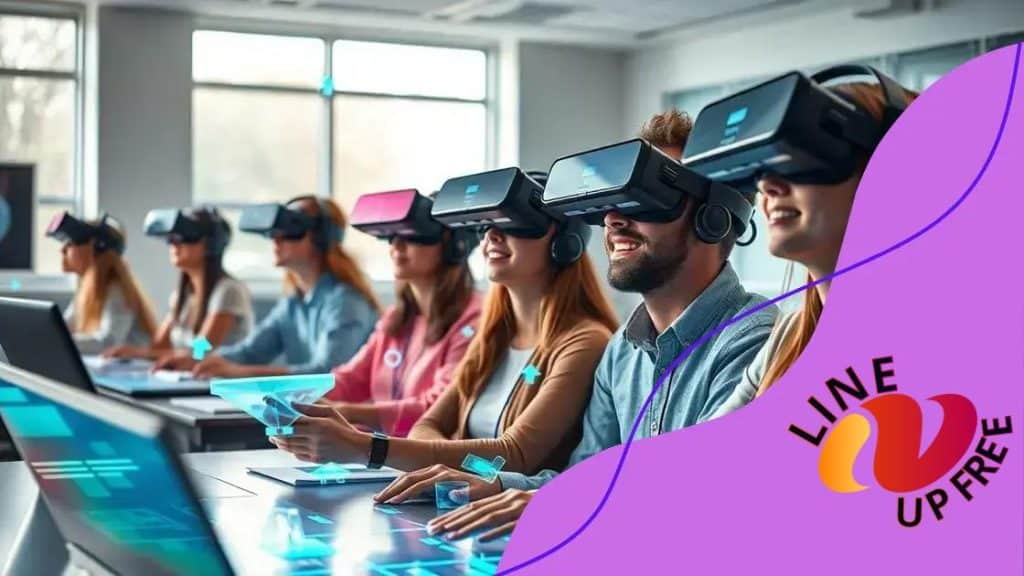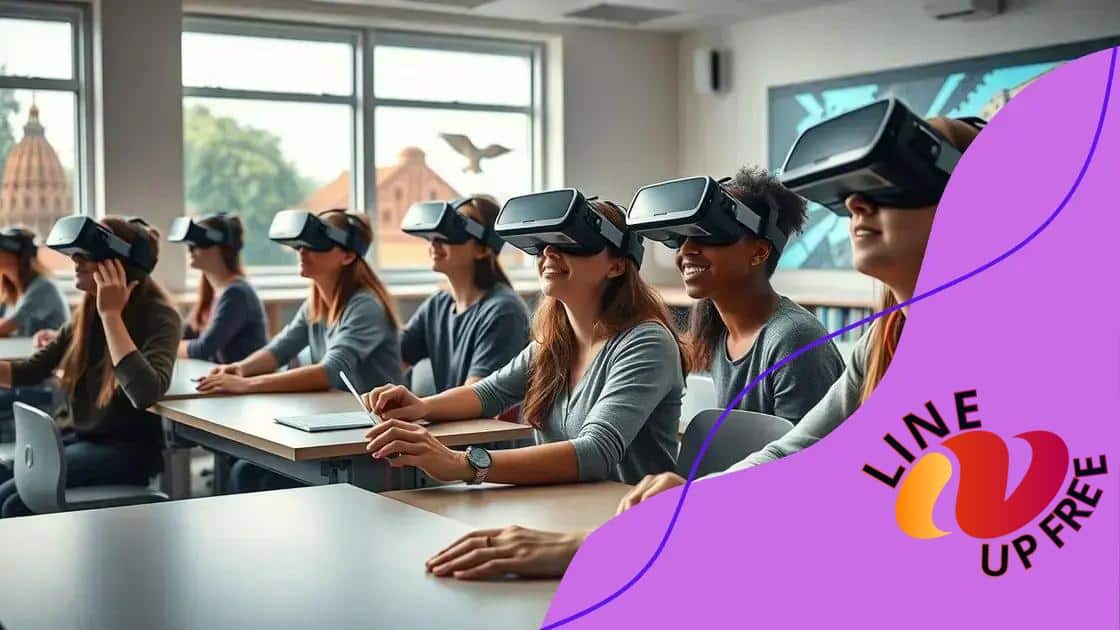How AR and VR are reshaping the way we learn

Anúncios
AR and VR technologies are revolutionizing education by providing immersive, interactive learning experiences that enhance student engagement, promote personalized learning, and prepare learners for future challenges in a tech-driven world.
Imagine a classroom where learning isn’t just about textbooks. How AR and VR are reshaping the way we learn opens up immersive experiences that engage students like never before. Curious about its impacts? Let’s dive in.
Anúncios
Understanding augmented and virtual reality in education
Understanding augmented and virtual reality (AR and VR) in education is essential for grasping how these technologies can transform learning. As students interact with dynamic environments, they can explore subjects in ways that were previously unimaginable. AR and VR offer immersive experiences that stimulate curiosity and engagement.
What is Augmented Reality?
Augmented Reality enriches the real world by adding digital information, enhancing the way we view our surroundings. For example, with AR, students can visualize complex scientific models or historical artifacts right in their classroom.
What is Virtual Reality?
Virtual Reality, on the other hand, creates a fully interactive and immersive environment, allowing students to explore different worlds or scenarios. This technology can transport them to a historical site or even into the depths of space!
Anúncios
- Interactivity: Engaging directly with content makes learning more memorable.
- Real-world simulations: Students can practice skills in safe, enclosed spaces.
- Visual learning: Concepts come to life through vivid presentations.
Both AR and VR serve to deepen understanding. Imagine studying anatomy by disassembling a virtual body or learning about ecosystems by exploring a rainforest from your classroom. These technologies remove the barriers to understanding complex ideas.
Furthermore, AR and VR cater to diverse learning styles. Visual learners benefit from vibrant graphics, while kinesthetic learners engage through hands-on interaction. This flexibility encourages students to take charge of their learning journey.
Examples in Action
In modern classrooms, AR and VR are becoming staples. For instance, apps like Google Expeditions allow teachers to take students on virtual field trips, exploring everything from the pyramids of Egypt to the surface of Mars. These experiences ignite a passion for learning.
By incorporating AR and VR into the educational framework, instructors create a more inclusive environment. All students can access unique resources tailored to their interests and needs, fostering creativity and collaboration.
In conclusion, understanding AR and VR in education reveals their potential to reshape learning into an engaging and interactive adventure. As technology advances, educators can expect to harness these tools to enhance educational experiences.
Benefits of AR and VR in learning environments
The benefits of AR and VR in learning environments are vast and impactful. These technologies fundamentally change the way students engage with educational content, making learning more interactive and enjoyable. By immersing learners in virtual experiences, comprehension can soar.
Enhanced Engagement
AR and VR create immersive environments that capture students’ attention. Unlike traditional methods, students can explore subjects actively instead of passively consuming information. This engagement leads to greater retention of knowledge.
Real-world Applications
One major benefit is the ability to simulate real-world scenarios. For example, medical students can practice surgical techniques in a virtual setting without the risks associated with real patients. This hands-on experience solidifies learning.
- Increased Motivation: Students are often more excited to learn when using AR and VR tools.
- Collaboration: These technologies foster teamwork, as students can work together in virtual spaces.
- Diverse Learning Styles: Visual and tactile learners particularly benefit from these formats, gaining deeper understanding.
Moreover, AR and VR allow for personalized learning experiences. Students can progress at their own pace, exploring areas of interest or revisiting complex topics without pressure. This flexibility empowers learners to take control of their education.
Additionally, these technologies bridge the gap between theoretical concepts and practical application. For example, in STEM education, students can visualize complex structures or processes, leading to enhanced problem-solving skills. The virtual exploration makes learning both enjoyable and effective.
Accessibility
AR and VR also improve accessibility for students with special needs. By providing tailored educational experiences, these tools enable all learners to thrive. For instance, a student with dyslexia might find it easier to engage with interactive content rather than traditional texts.
In summary, the incorporation of AR and VR into educational settings offers numerous benefits, enriching the learning experience and fostering a more dynamic, inclusive environment. As technology continues to evolve, so will the ways we can enhance education through these innovative tools.
Real-world applications of AR and VR in classrooms

Real-world applications of AR and VR in classrooms are changing the landscape of education. These technologies enable students to experience lessons in ways that enhance understanding and engagement. By bringing abstract concepts to life, AR and VR make learning more interactive.
Exploring History
Imagine walking through ancient Rome without leaving your classroom. With VR, students can explore historical sites as if they were really there. This immersive experience helps them better grasp the context and significance of historical events.
- Interactive timelines: Students can visualize events in chronological order, enhancing their understanding.
- Virtual field trips: Explore museums, landmarks, and natural wonders across the globe.
- Engagement with artifacts: Examine replicas of ancient tools and documents in 3D.
In science education, AR and VR allow learners to interact with complex models. For instance, biology students can manipulate a 3D model of a cell, allowing them to observe its components up close. Such practical knowledge reinforces theoretical concepts and aids retention.
STEM Education
STEM educators utilize VR to simulate real-world engineering challenges. Students can participate in virtual labs without the costs and safety concerns of real materials. This hands-on experience not only sparks interest but also builds critical thinking and problem-solving skills.
Furthermore, VR can facilitate programming education. Students can write code that controls virtual robots, fostering both creativity and logical reasoning. This form of combined learning, known as project-based learning, connects students to real-world applications.
In language learning, AR apps enhance vocabulary acquisition by overlaying images and definitions onto real-world objects. As students scan items around them, they can learn new words in context, facilitating a deeper understanding.
Special Education
Special education also benefits immensely from these technologies. For students with autism, VR can provide safe environments to practice social skills. They can interact with virtual characters, gradually building confidence with real-world interactions.
By integrating AR and VR into classrooms, educators create a dynamic learning space that appeals to diverse learning styles. As a result, all students can benefit from a richer educational experience, boosting their motivation and engagement.
Challenges in implementing AR and VR for education
Challenges in implementing AR and VR for education can create barriers that educators must navigate to effectively harness these technologies. While the benefits are significant, several obstacles can hinder successful integration into the classroom. Understanding these challenges is key to overcoming them.
Cost of Technology
One major challenge is the cost associated with AR and VR technologies. The devices themselves can be expensive, and not all schools have the budget to purchase them. Beyond just the hardware, schools also need to invest in software, training, and maintenance.
- Initial investment: Schools may struggle to allocate funds for new technologies.
- Ongoing costs: Software updates and additional resources can add to expenses.
- Hardware limitations: Not all classrooms are equipped with the necessary infrastructure to support these technologies.
Another challenge is the steep learning curve that teachers face with AR and VR. Many educators may feel intimidated by the technology and require training to effectively integrate it into their lesson plans. This can lead to hesitancy in adoption, stalling the potential benefits these tools offer.
Content Availability
Content availability presents another hurdle. While some educational AR and VR applications exist, there is still a limited selection of high-quality resources that align with curriculum standards. Teachers may find it challenging to locate appropriate tools that meet their specific educational goals.
Additionally, the rapid evolution of technology can lead to content becoming outdated quickly. This means schools need to continually invest in new resources, further complicating the integration process. With the curriculum changing rapidly, educators often find it difficult to keep pace with technological advancements.
Technical Issues
Technical issues are another significant concern in classrooms. AR and VR technology can sometimes be unreliable, with connectivity problems or software glitches frustrating both students and teachers. When technology fails, it can disrupt the learning process and diminish enthusiasm for these tools.
Furthermore, not all students may have equal access to AR and VR technology outside school. This digital divide can create inequalities, where some students benefit from immersive experiences while others are left behind. Addressing this disparity is crucial to ensure that all students have a fair chance to thrive in a tech-enhanced learning environment.
Overall, while challenges in implementing AR and VR for education are notable, they can be addressed through proper training, resource allocation, and infrastructure improvements. By being aware of these challenges, educators can work towards finding effective solutions that enhance student learning.
The future of learning with AR and VR technologies
The future of learning with AR and VR technologies holds exciting possibilities. As these tools become more accessible, they will significantly alter how education is delivered and experienced. Students will immerse themselves in dynamic learning environments that enhance their understanding of various subjects.
Personalized Education
AR and VR will enable a more personalized education experience for each student. With adaptive learning programs, students can progress at their own pace, focusing on areas that require more attention. This individualized approach helps to ensure that every learner can succeed.
- Customizable learning paths: Students can choose topics that interest them, creating more engagement.
- Instant feedback: Immediate responses from AR and VR applications can reinforce learning.
- Diverse formats: Interactive experiences cater to varied learning styles, enhancing comprehension.
Furthermore, as technology continues to evolve, the applications for AR and VR will expand. For example, virtual classrooms could connect students from around the globe, promoting collaboration and cultural exchange. Imagine working on a science project with peers from different countries using shared virtual labs.
Enhanced Collaboration
Collaboration will take on a new dimension in the future of learning. As students work together in AR and VR environments, they will develop teamwork and communication skills essential for their future careers. Virtual reality can simulate real-world challenges where students must collaborate to solve problems.
Additionally, educators can participate in professional development using VR simulations. Teachers will have opportunities to practice classroom management in a virtual space, enhancing their skills before applying them in real classrooms.
Access to Resources
The future will also see improved access to educational resources. AR can provide instant information by overlaying data on real-world objects. For example, students studying biology could point their devices at a plant and learn its name, habitat, and uses without needing textbooks.
Moreover, VR will allow students to explore otherwise inaccessible locations, such as the depths of the ocean or outer space. This capability opens up new learning avenues, sparking curiosity and encouraging exploration beyond traditional classroom boundaries.
In summary, the integration of AR and VR technologies into education promises to enrich learning experiences, making education more personalized, collaborative, and accessible. As these technologies advance, they will reshape the educational landscape and prepare students for an ever-evolving world.
In conclusion, the integration of AR and VR technologies into education has the potential to revolutionize learning. These tools create immersive and engaging experiences that can personalize education, foster collaboration, and make learning more accessible. While challenges like costs and technology limitations exist, the benefits far outweigh them. As we look to the future, embracing these technologies can inspire students and enhance their educational journey, preparing them for a rapidly changing world.
FAQ – Frequently Asked Questions about AR and VR in Education
What are AR and VR technologies?
Augmented Reality (AR) enhances the real world with digital information, while Virtual Reality (VR) creates entirely immersive environments that simulate real or imagined experiences.
How can AR and VR improve student engagement?
AR and VR create interactive and immersive learning experiences that capture students’ attention and motivate them to actively participate in their education.
What challenges do schools face when implementing AR and VR?
Schools may encounter challenges like high costs, limited access to technology, a steep learning curve for educators, and the need for suitable content.
How do AR and VR technologies prepare students for the future?
These technologies equip students with essential skills such as collaboration, problem-solving, and digital literacy, which are crucial for success in a technology-driven world.





